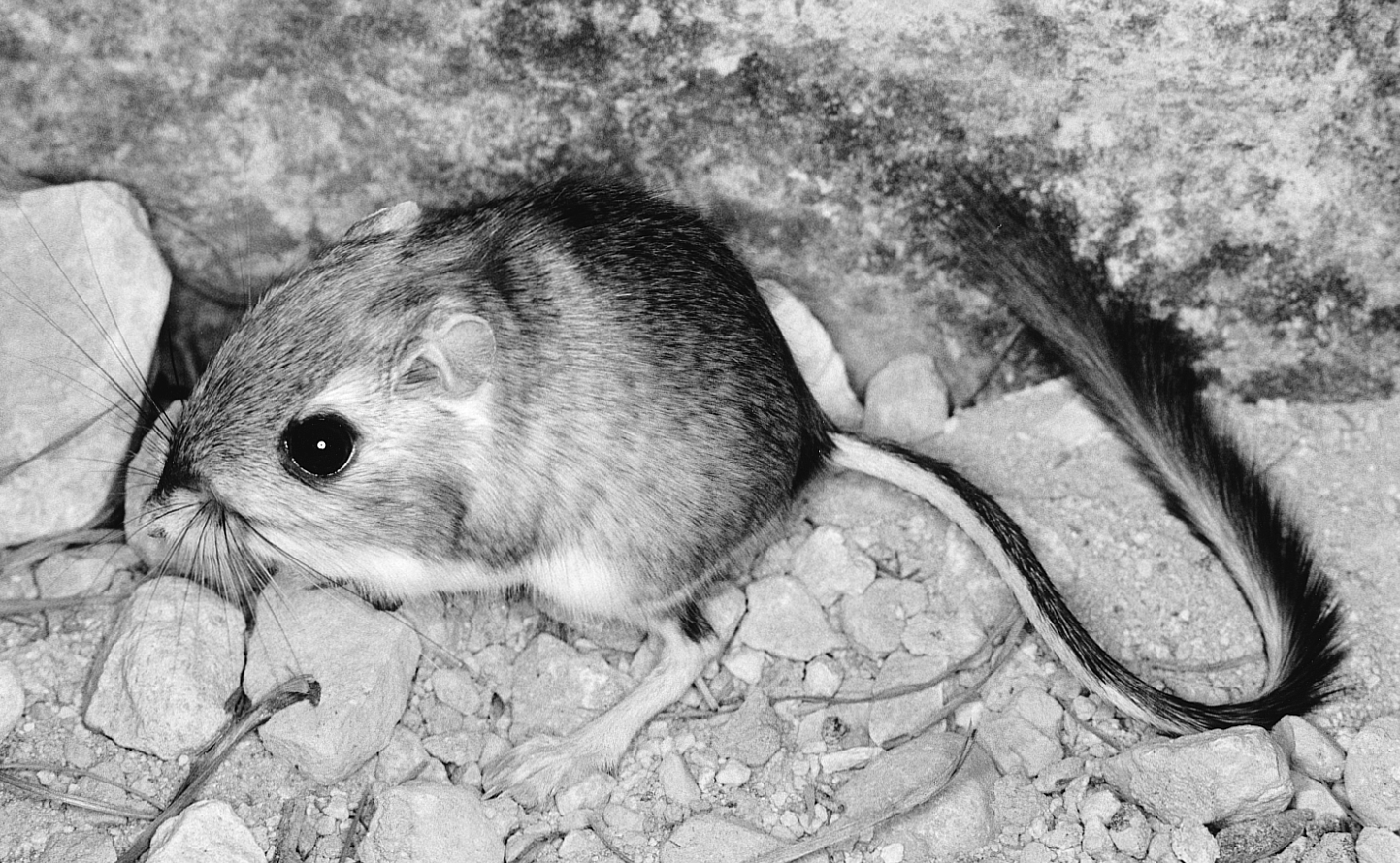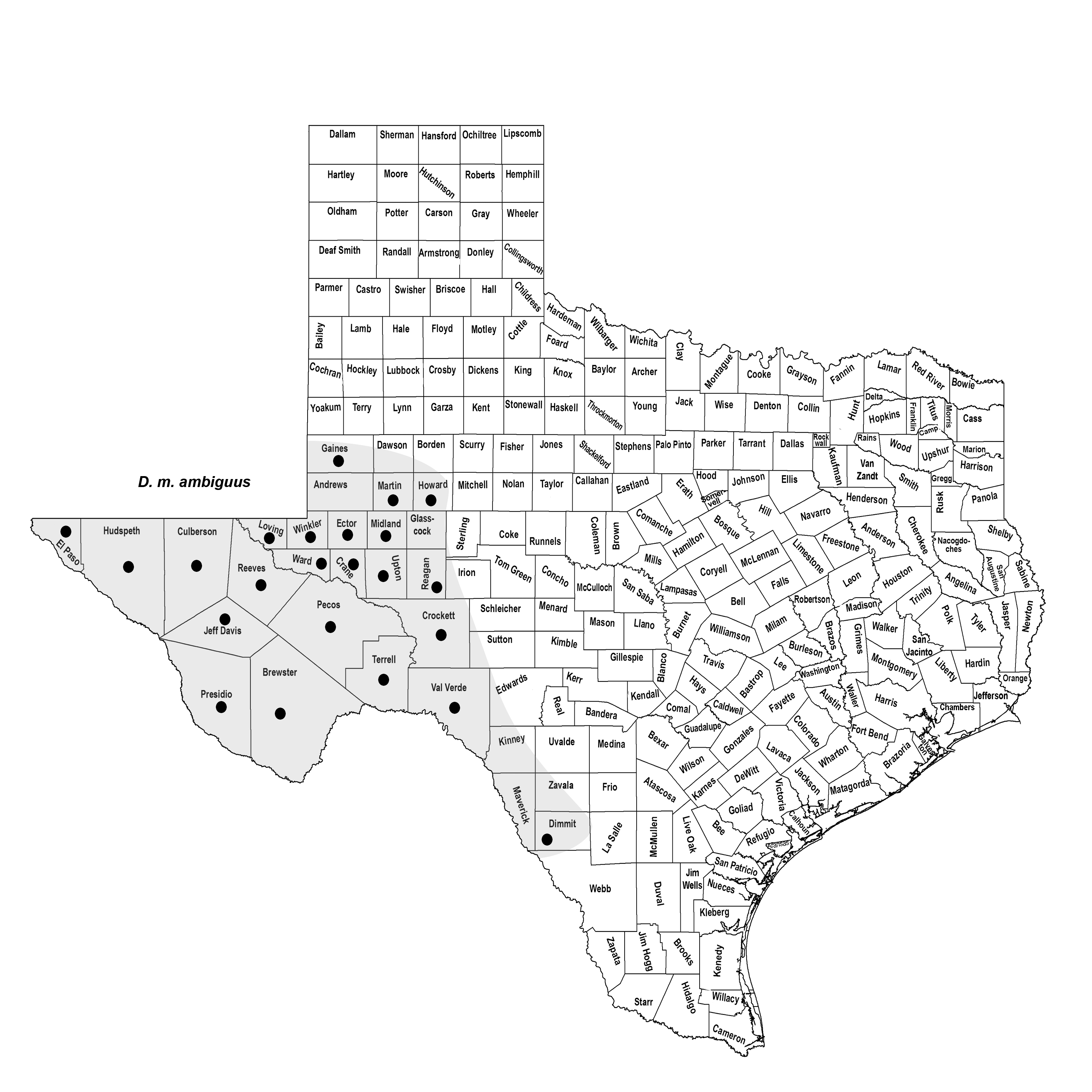MERRIAM'S KANGAROO RAT
Dipodomys merriami Mearns 1890
Order Rodentia : Family Heteromyidae
DESCRIPTION. A small, four-toed, usually buff-colored kangaroo rat; tail rather long, usually >130% of length of head and body, tip dusky, and dorsal and ventral dusky stripes usually present; length of head and body usually <105 mm; dark facial markings rather pale; underparts white; pelage silky. Dental formula: I 1/1, C 0/0, Pm 1/1, M 3/3 × 2 = 20. Averages for external measurements: total length, 247 mm; tail, 144 mm; hind foot, 39 mm. Weight, 40–50 g.

DISTRIBUTION. A rodent of the Southwest; known in Texas primarily from the Trans-Pecos northeastward to Gaines and Midland counties in the north, to the extreme western portion of the Edwards Plateau, and to Dimmit County in the south.

SUBSPECIES. Dipodomys m. ambiguus.
HABITS. In its habitat requirements this species is more tolerant than most other species of kangaroo rats. It apparently can succeed equally well on sandy soils, clays, gravels, and even among rocks. Where merriami occurs with D. ordii or some other less-tolerant and sand-dwelling kangaroo rat, merriami usually inhabits the harder, stonier soils. In Trans-Pecos Texas, the usual relationship follows: D. ordii is found in areas of loose sands and D. merriami in areas of clayey or stony soils that are not suitable habitat for the other species. On the Llano Estacado, D. merriami occurs along the southern part of the region where creosote bush is common.
Their burrows are usually simple in design, shallow, and with openings near the bases of shrubs. Usually, only one adult occupies each burrow system.
Their food is almost entirely seeds. Seeds of mesquite, creosote bush, purslane, ocotillo, and grama grass have been found in their cheek pouches as well as green vegetation and insects. A study of D. merriami in the Guadalupe Mountains showed that seeds make up 64% of the diet, with seeds of shrubs constituting 23%, those of forbs 24%, those of grasses 4.5%, and those of succulent plants 12%. The diet varies seasonally, but seeds, green vegetation, and insects are eaten throughout the year. Green vegetation is most important in midsummer, and insects are eaten in greatest abundance in winter.
This kangaroo rat breeds throughout the year in the Big Bend region, with pregnant
females having been taken in all months except December–February. The number of young
per litter ranges from one to five, averaging about three. The gestation period is
29 days, and sexual maturity of young is usually attained in 60 days.
This species is not important economically. On rangelands the rats may do some damage
by consuming seeds of grasses, but in general, losses attributable to them are negligible.
POPULATION STATUS. Common. Merriam's kangaroo rat is one of the most common kangaroo rats in the state.
CONSERVATION STATUS. The IUCN lists Merriam's kangaroo rat as a species of least concern, and it does not appear on the federal or state lists of concerned species. It does not appear to face any major threats at the present time.
From The Mammals of Texas, Seventh Edition by David J. Schmidly and Robert D. Bradley, copyright © 1994, 2004, 2016. Courtesy of the University of Texas Press.
Natural Science Research Laboratory
-
Address
Museum of Texas Tech University, 3301 4th street, Lubbock, TX 79409 -
Phone
806.742.2486 -
Email
nsrl.museum@ttu.edu

